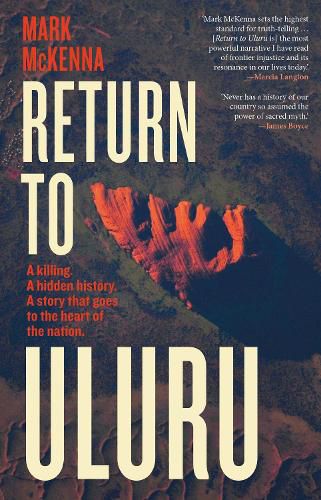Readings Newsletter
Become a Readings Member to make your shopping experience even easier.
Sign in or sign up for free!
You’re not far away from qualifying for FREE standard shipping within Australia
You’ve qualified for FREE standard shipping within Australia
The cart is loading…






When Mark McKenna set out to write a history of the centre of Australia, he had no idea what he would discover. One event in 1934 - the shooting at Uluru of Aboriginal man Yokunnuna by white policeman Bill McKinnon, and subsequent Commonwealth inquiry - stood out as a mirror of racial politics in the Northern Territory at the time.
But then, through speaking with the families of both killer and victim, McKenna unearthed new evidence that transformed the historical record and the meaning of the event for today. As he explains, ‘Every thread of the story connected to the present in surprising ways.’ In a sequence of powerful revelations, McKenna explores what truth-telling and reconciliation look like in practice.
Return to Uluru brings a cold case to life. It speaks directly to the Black Lives Matter movement, but is completely Australian. Recalling Chloe Hooper’s The Tall Man, it is superbly written, moving, and full of astonishing, unexpected twists. Ultimately it is a story of recognition and return, which goes to the very heart of the country. At the centre of it all is Uluru, the sacred site where paths fatefully converged.
‘I feel sure that it will become an Australian classic, not the first of its kind, but certainly the most powerful narrative I have read of frontier injustice and its resonance in our lives today.’ - Marcia Langton
$9.00 standard shipping within Australia
FREE standard shipping within Australia for orders over $100.00
Express & International shipping calculated at checkout
When Mark McKenna set out to write a history of the centre of Australia, he had no idea what he would discover. One event in 1934 - the shooting at Uluru of Aboriginal man Yokunnuna by white policeman Bill McKinnon, and subsequent Commonwealth inquiry - stood out as a mirror of racial politics in the Northern Territory at the time.
But then, through speaking with the families of both killer and victim, McKenna unearthed new evidence that transformed the historical record and the meaning of the event for today. As he explains, ‘Every thread of the story connected to the present in surprising ways.’ In a sequence of powerful revelations, McKenna explores what truth-telling and reconciliation look like in practice.
Return to Uluru brings a cold case to life. It speaks directly to the Black Lives Matter movement, but is completely Australian. Recalling Chloe Hooper’s The Tall Man, it is superbly written, moving, and full of astonishing, unexpected twists. Ultimately it is a story of recognition and return, which goes to the very heart of the country. At the centre of it all is Uluru, the sacred site where paths fatefully converged.
‘I feel sure that it will become an Australian classic, not the first of its kind, but certainly the most powerful narrative I have read of frontier injustice and its resonance in our lives today.’ - Marcia Langton
By most measures Uluru is just a few hundred kilometres from the geographic centre of Australia. The location of the centre fascinated explorers such as Charles Sturt and Cecil Madigan. It’s held an equal fascination for historian Mark McKenna. While the history of Australia’s colonisation centres on the coastal fringe, the harsh centre has never really been ‘conquered’, he argues. For First Nations people, ‘the Centre’ gives them material and spiritual life; for the European invaders, it was something to be tamed. For the Anangu people especially, but for other First Nations people as well, Uluru has the same symbolism and meaning as the greatest religious buildings of Europe. It’s no accident that the historic Uluru Statement from the Heart was delivered from this sacred site. According to Europeans like Madigan, Indigenous life and culture would be swept away by the onslaught of ‘civilisation’. Rather than participate in their decline, ‘the Aboriginal people of Central Australia both enabled European settlement and outlasted it’, argues McKenna.
It was the discovery of a little-known incident in 1934 that changed the way McKenna approached and thought about his book on ‘the Centre’. This incident forms the basis of the narrative to Return to Uluru. In 1934, a Pitjantjatjara man was executed by a group of men for infringing tribal law. Northern Territory policeman Bill McKinnon was tasked with tracking down the murderers and eventually arrested six suspects. On the trip back to Alice, the men escaped and were pursued by McKinnon. One, Yokununna, was wounded and tracked to a cave at the base of Uluru. Cornered, Yokununna threw rocks through an opening and McKinnon fired into the cave fatally wounding the man. McKinnon claimed that he acted in self-defence and didn’t intend to seriously harm Yokununna. A board of inquiry loaded with friends of McKinnon exonerated him.
McKenna delves into the case, including an eyewitness survivor who gives a disturbing account that contradicts the official rulings. In a Queensland garage, McKenna uncovers McKinnon’s meticulous records of his policing career and the truth to the story. This is dark story in our history, but in its discovery, McKenna finds some hope of reconciliation.